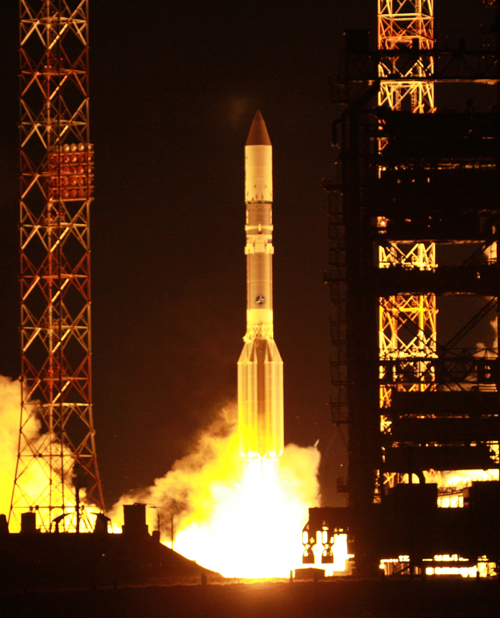Russian Rocket Successfully Launches New Communications Satellite

PARIS — An International Launch Services (ILS) Proton rocket on April 24 successfully placed the Yahsat 1B Ka-band civil/military telecommunications satellite into geostationary transfer orbit.
The launch completes the current in-orbit development program of Al Yah Satellite Communications of Abu Dhabi, United Arab Emirates, following the April 2011 launch of Yahsat 1A, which carries a mixed Ku-, C- and Ka-band payload.
Both spacecraft were built by Astrium Satellites and Thales Alenia Space of Europe under a $1.66 billion contract that included the satellites’ launch and the network ground infrastructure. Astrium Services, which is Astrium’s service-provision arm and is overall prime contractor for the Yahsat system, will operate the two satellites with Thales Communication and Security for five years and provide training to Emirati personnel under the contract. [Amazing Russian Rocket Launch Photos]
Yahsat 1B’s all-Ka-band payload will provide commercial broadband links through Yahsat’s YahClick service. Military Ka-band will be offered through a service called YahSecure.
YahSecure features a regional beam centered on Yahsat’s region. A global beam offers Ka-band to Southern, Central and Eastern Europe, all of Africa, and a large swath covering Central and South Asia, including India, and eastward including most of China and Southeast Asia.
The Ka-band service will also be allocated through 61 narrow spot beams.
The Yahsat 1B launch, from Russia’s Baikonur Cosmodrome in Kazakhstan, was followed by a cruise phase of the Proton’s Breeze M upper stage lasting nine hours and 12 minutes and including five engine ignitions before the 6,000-kilogram Yahsat 1B was released into orbit.
Get the Space.com Newsletter
Breaking space news, the latest updates on rocket launches, skywatching events and more!
The launch was the third of 2012 for Reston, Va.-based ILS, and the fourth Proton rocket launch of the year. One of the Proton missions lofted a Russian government satellite.
This article was provided by Space News, dedicated to covering all aspects of the space industry.
Join our Space Forums to keep talking space on the latest missions, night sky and more! And if you have a news tip, correction or comment, let us know at: community@space.com.

Charles Q. Choi is a contributing writer for Space.com and Live Science. He covers all things human origins and astronomy as well as physics, animals and general science topics. Charles has a Master of Arts degree from the University of Missouri-Columbia, School of Journalism and a Bachelor of Arts degree from the University of South Florida. Charles has visited every continent on Earth, drinking rancid yak butter tea in Lhasa, snorkeling with sea lions in the Galapagos and even climbing an iceberg in Antarctica. Visit him at http://www.sciwriter.us

